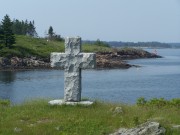1492-1650
European explorers cruise the Maine coast in search of opportunities for their patrons, especially in the rich fisheries of the Gulf of Maine. Missionaries and settlers follow, bringing diseases that devastate Native American populations.
1492
|
Christopher Columbus “discovers” America. |
1497 |
John and Sebastian Cabot sail from England to North America and return to England |
1498 |
Sebastian Cabot explores North American coast, establishes England’s claim. |
1500 |
Gaspar Cortereal, sailing for Portugal searching to find the fabled “Northwest Passage” to the Far East, travels along the Maine coast. |
1524
|
Giovanni da Verrazano establishes claim for France, describes Maine coast. He also described “high country full of very dense forests, composed of pines, cypresses, and similar trees which grow in cold regrions.”* |
1525
|
Estevan Gomez, sailing for Charles V of Spain and seeking the Northwest Passage, enters many Maine harbors. |
1527 |
John Rut explores the interior of Maine for England. |
1556 |
Andre Thevet explores the Penobscot River for France. |
1583 |
Sir Humphrey Gilbert explores the Maine coast for England. |
1602 |
Bartholomew Gosnold explores the Maine coast, seeking a suitable location for a British colony and making his first landfall at Cape Elizabeth. |
1603 |
Martin Pring explores Penobscot Bay for Bristol, England businessmen. |
1604 |
First French settlement in Maine at St. Croix island in the St. Croix river. Samuel de Champlain explored the Maine coast, including Mount Desert Island. |
1605 |
George Weymouth sails from England on March 31. His expedition lands on Monhegan Island; explores the Maine coast; and kidnaps five Indians to England. He explores Allen Island where a cross was erected in 1907 to commemorate, 300 years later, Maine’s first church service held by Weymouth on the island. |
1606 |
Southern Maine granted to Plymouth Colony under the first Virginia Charter. |
1607 |
Popham colonists land and begin to organize their colony in Maine. Jamestown colony in Virginia founded as first permanent English settlement. |
1608 |
The pinnace Virginia, first ship built in Maine, launched at Popham. After a hard winter, Popham colonists return to England. |
1609 |
Jesuit mission established by French on Penobscot Bay |
1613
|
Jesuit mission established by French on Mount Desert Island. |
1614
|
Captain John Smith maps the New England Coast |
1616 |
An epidemic spreads through the Native American tribes, from Penobscot Bay westward. Called “The Great Dying,” an estimated 70-90% of the Native population dies from European diseases during 1616-1619. |
1620 |
Pilgrims establish Plymouth Colony; draft the Mayflower Compact. |
1622 |
Starving Plymouth Pilgrims get supplies/food from fishermen at Damariscove Island. All land between Merrimac and Kennebec rivers granted to Gorges and Mason. |
1624 |
John Smith describes the coast north of the Penobscot: “a Countrey rather to affright than delight one, and how to describe a more plaine spectacle of desolation, or more barren, I know not.”* |
1625 |
Pilgrims begin trade with Indians on the Kennebec River. First deed of Maine land, from Indians to John Brown of New Harbor. |
1628 |
First charter issued for the government of MassachusettsFur trading post built by the Pilgrims at Cushnoc (Augusta) after a trip in a small sailing vessel – a shallop – by John Howland, a Plymouth-Colony leader and later manager of the post. |
1630 |
Settlement begins in the town of Agamenticus, now the Town of York. |
1632 |
England cedes Acadia to France. |
1635
|
French Fort Pentagoet constructed in Castine. First hurricane to hit North American settlers strikes Massachusetts Bay and Plymouth colonies. |
1639 |
King Charles I officially changes the name to Province of Maine. Grant of the Province of Maine exclusively to Sir Fernando Gorges. |
1641
|
Incorporation of the first Maine city of Agamenticus, now the Town of York. |
1642 |
Name of Agamenticus changed to Georgeanna for Sir Fernando Gorges. |
1646 |
First mill built on the Presumpscot River near present day Portland and Falmouth |
*Quoted in Cronin, William. Changes in the Land: Indians, Colonists, and the Ecology of New England. New York. Hill and Wang. 1983. p. 26.
PREVIOUS SECTION – – – – – – – – – – – – – – – NEXT SECTION


